technical specifications FORD F-150 2020 Owners Manual
[x] Cancel search | Manufacturer: FORD, Model Year: 2020, Model line: F-150, Model: FORD F-150 2020Pages: 625, PDF Size: 7.98 MB
Page 9 of 625
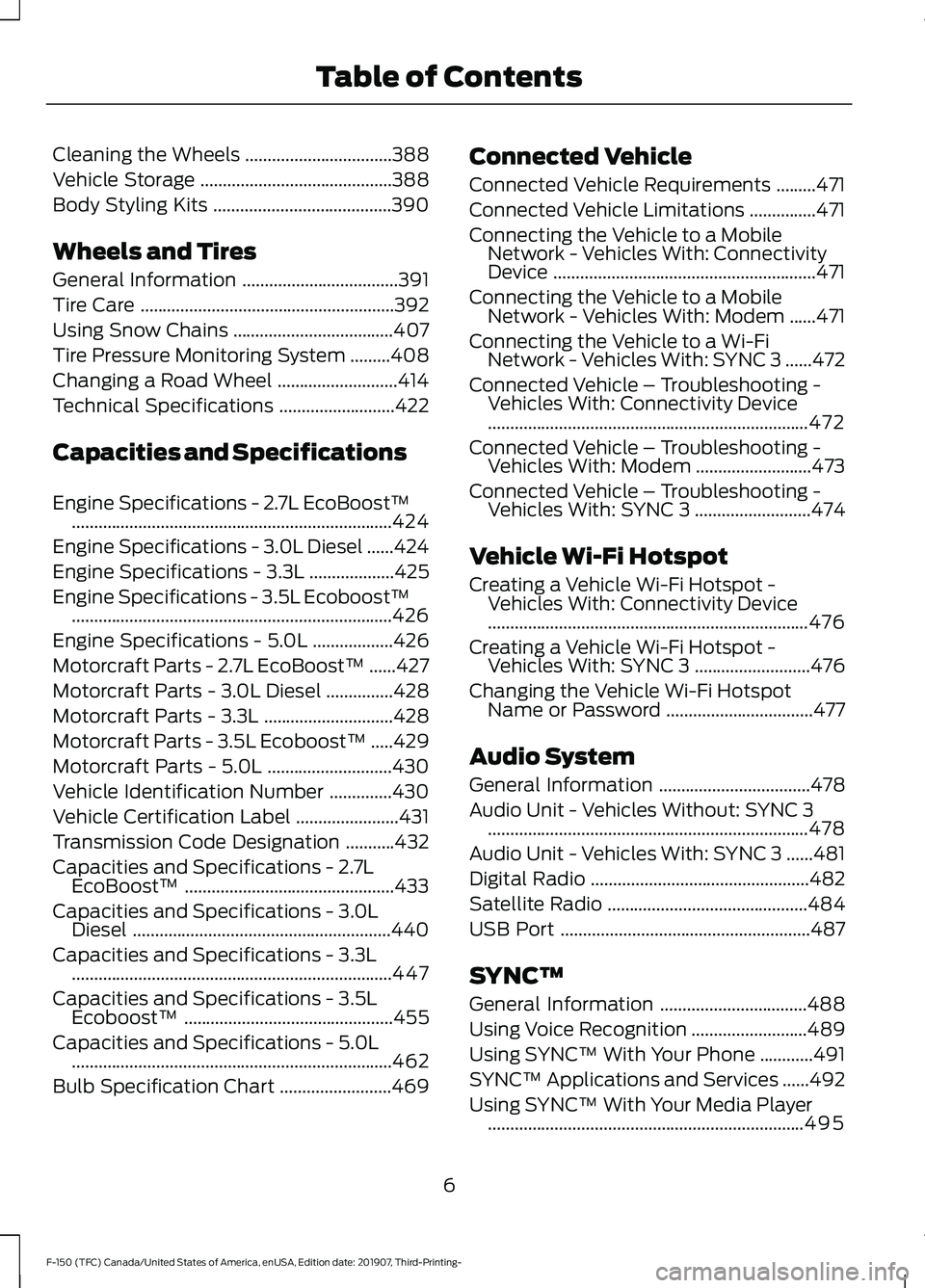
Cleaning the Wheels
.................................388
Vehicle Storage ...........................................
388
Body Styling Kits ........................................
390
Wheels and Tires
General Information ...................................
391
Tire Care .........................................................
392
Using Snow Chains ....................................
407
Tire Pressure Monitoring System .........
408
Changing a Road Wheel ...........................
414
Technical Specifications ..........................
422
Capacities and Specifications
Engine Specifications - 2.7L EcoBoost™ ........................................................................\
424
Engine Specifications - 3.0L Diesel ......
424
Engine Specifications - 3.3L ...................
425
Engine Specifications - 3.5L Ecoboost™ ........................................................................\
426
Engine Specifications - 5.0L ..................
426
Motorcraft Parts - 2.7L EcoBoost™ ......
427
Motorcraft Parts - 3.0L Diesel ...............
428
Motorcraft Parts - 3.3L .............................
428
Motorcraft Parts - 3.5L Ecoboost™ .....
429
Motorcraft Parts - 5.0L ............................
430
Vehicle Identification Number ..............
430
Vehicle Certification Label .......................
431
Transmission Code Designation ...........
432
Capacities and Specifications - 2.7L EcoBoost™ ...............................................
433
Capacities and Specifications - 3.0L Diesel ..........................................................
440
Capacities and Specifications - 3.3L ........................................................................\
447
Capacities and Specifications - 3.5L Ecoboost™ ...............................................
455
Capacities and Specifications - 5.0L ........................................................................\
462
Bulb Specification Chart .........................
469Connected Vehicle
Connected Vehicle Requirements
.........
471
Connected Vehicle Limitations ...............
471
Connecting the Vehicle to a Mobile Network - Vehicles With: Connectivity
Device ...........................................................
471
Connecting the Vehicle to a Mobile Network - Vehicles With: Modem ......
471
Connecting the Vehicle to a Wi-Fi Network - Vehicles With: SYNC 3 ......
472
Connected Vehicle – Troubleshooting - Vehicles With: Connectivity Device
........................................................................\
472
Connected Vehicle – Troubleshooting - Vehicles With: Modem ..........................
473
Connected Vehicle – Troubleshooting - Vehicles With: SYNC 3 ..........................
474
Vehicle Wi-Fi Hotspot
Creating a Vehicle Wi-Fi Hotspot - Vehicles With: Connectivity Device
........................................................................\
476
Creating a Vehicle Wi-Fi Hotspot - Vehicles With: SYNC 3 ..........................
476
Changing the Vehicle Wi-Fi Hotspot Name or Password .................................
477
Audio System
General Information ..................................
478
Audio Unit - Vehicles Without: SYNC 3 ........................................................................\
478
Audio Unit - Vehicles With: SYNC 3 ......
481
Digital Radio .................................................
482
Satellite Radio .............................................
484
USB Port ........................................................
487
SYNC™
General Information .................................
488
Using Voice Recognition ..........................
489
Using SYNC™ With Your Phone ............
491
SYNC™ Applications and Services ......
492
Using SYNC™ With Your Media Player .......................................................................
495
6
F-150 (TFC) Canada/United States of America, enUSA, Edition date: 201907, Third-Printing- Table of Contents
Page 63 of 625
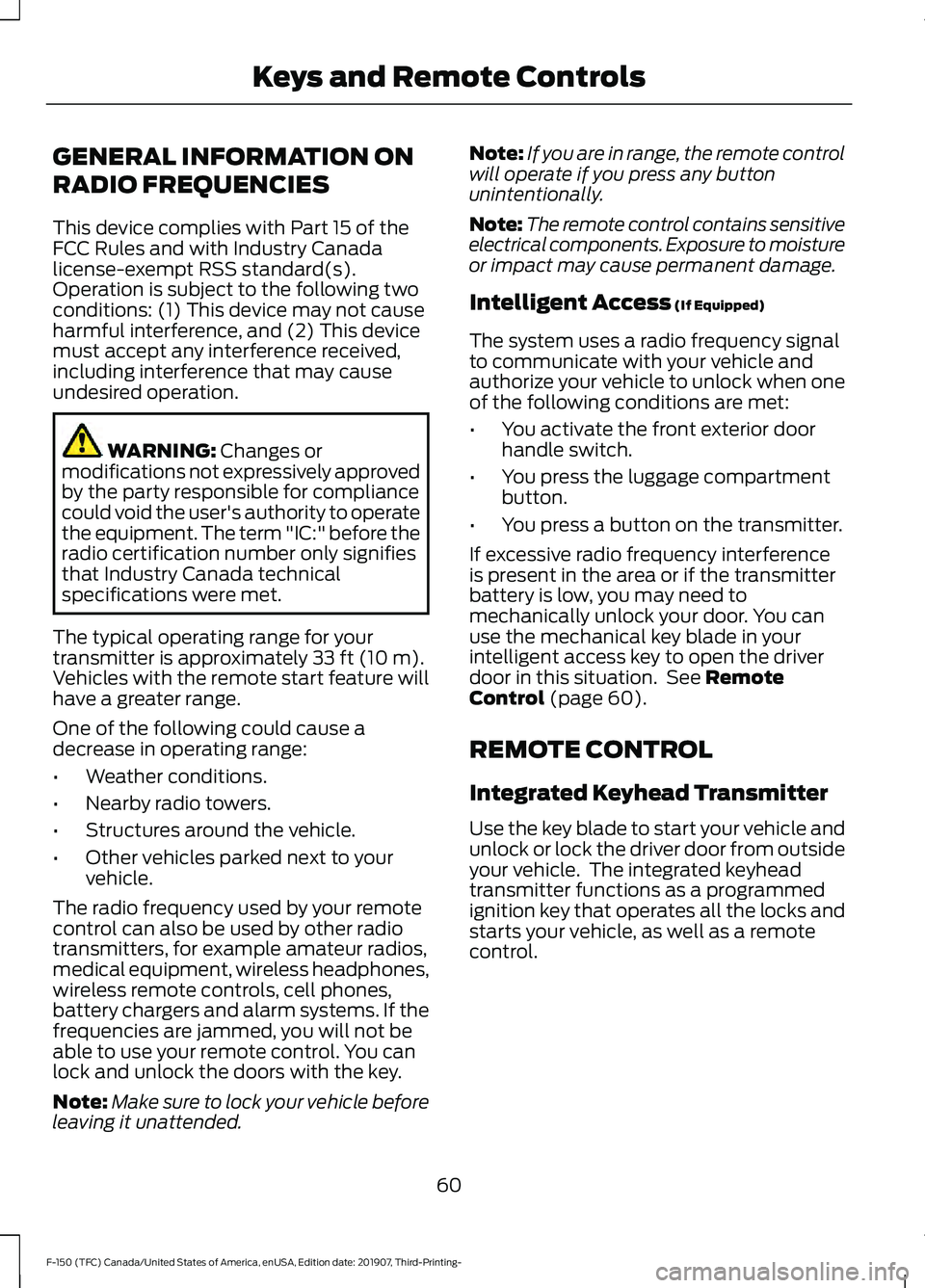
GENERAL INFORMATION ON
RADIO FREQUENCIES
This device complies with Part 15 of the
FCC Rules and with Industry Canada
license-exempt RSS standard(s).
Operation is subject to the following two
conditions: (1) This device may not cause
harmful interference, and (2) This device
must accept any interference received,
including interference that may cause
undesired operation.
WARNING: Changes or
modifications not expressively approved
by the party responsible for compliance
could void the user's authority to operate
the equipment. The term "IC:" before the
radio certification number only signifies
that Industry Canada technical
specifications were met.
The typical operating range for your
transmitter is approximately
33 ft (10 m).
Vehicles with the remote start feature will
have a greater range.
One of the following could cause a
decrease in operating range:
• Weather conditions.
• Nearby radio towers.
• Structures around the vehicle.
• Other vehicles parked next to your
vehicle.
The radio frequency used by your remote
control can also be used by other radio
transmitters, for example amateur radios,
medical equipment, wireless headphones,
wireless remote controls, cell phones,
battery chargers and alarm systems. If the
frequencies are jammed, you will not be
able to use your remote control. You can
lock and unlock the doors with the key.
Note: Make sure to lock your vehicle before
leaving it unattended. Note:
If you are in range, the remote control
will operate if you press any button
unintentionally.
Note: The remote control contains sensitive
electrical components. Exposure to moisture
or impact may cause permanent damage.
Intelligent Access
(If Equipped)
The system uses a radio frequency signal
to communicate with your vehicle and
authorize your vehicle to unlock when one
of the following conditions are met:
• You activate the front exterior door
handle switch.
• You press the luggage compartment
button.
• You press a button on the transmitter.
If excessive radio frequency interference
is present in the area or if the transmitter
battery is low, you may need to
mechanically unlock your door. You can
use the mechanical key blade in your
intelligent access key to open the driver
door in this situation. See
Remote
Control (page 60).
REMOTE CONTROL
Integrated Keyhead Transmitter
Use the key blade to start your vehicle and
unlock or lock the driver door from outside
your vehicle. The integrated keyhead
transmitter functions as a programmed
ignition key that operates all the locks and
starts your vehicle, as well as a remote
control.
60
F-150 (TFC) Canada/United States of America, enUSA, Edition date: 201907, Third-Printing- Keys and Remote Controls
Page 177 of 625
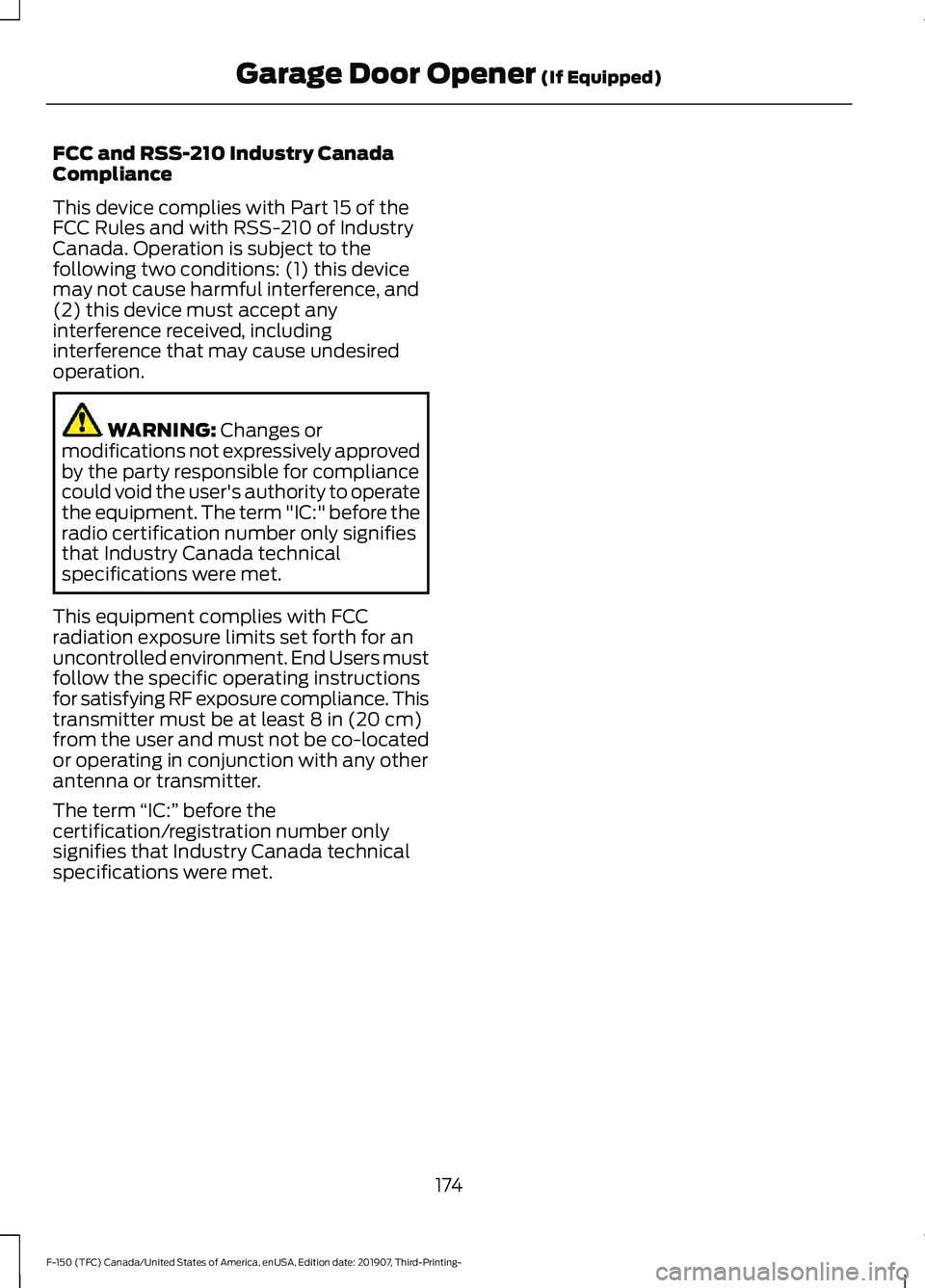
FCC and RSS-210 Industry Canada
Compliance
This device complies with Part 15 of the
FCC Rules and with RSS-210 of Industry
Canada. Operation is subject to the
following two conditions: (1) this device
may not cause harmful interference, and
(2) this device must accept any
interference received, including
interference that may cause undesired
operation.
WARNING: Changes or
modifications not expressively approved
by the party responsible for compliance
could void the user's authority to operate
the equipment. The term "IC:" before the
radio certification number only signifies
that Industry Canada technical
specifications were met.
This equipment complies with FCC
radiation exposure limits set forth for an
uncontrolled environment. End Users must
follow the specific operating instructions
for satisfying RF exposure compliance. This
transmitter must be at least
8 in (20 cm)
from the user and must not be co-located
or operating in conjunction with any other
antenna or transmitter.
The term “IC:” before the
certification/registration number only
signifies that Industry Canada technical
specifications were met.
174
F-150 (TFC) Canada/United States of America, enUSA, Edition date: 201907, Third-Printing- Garage Door Opener
(If Equipped)
Page 412 of 625
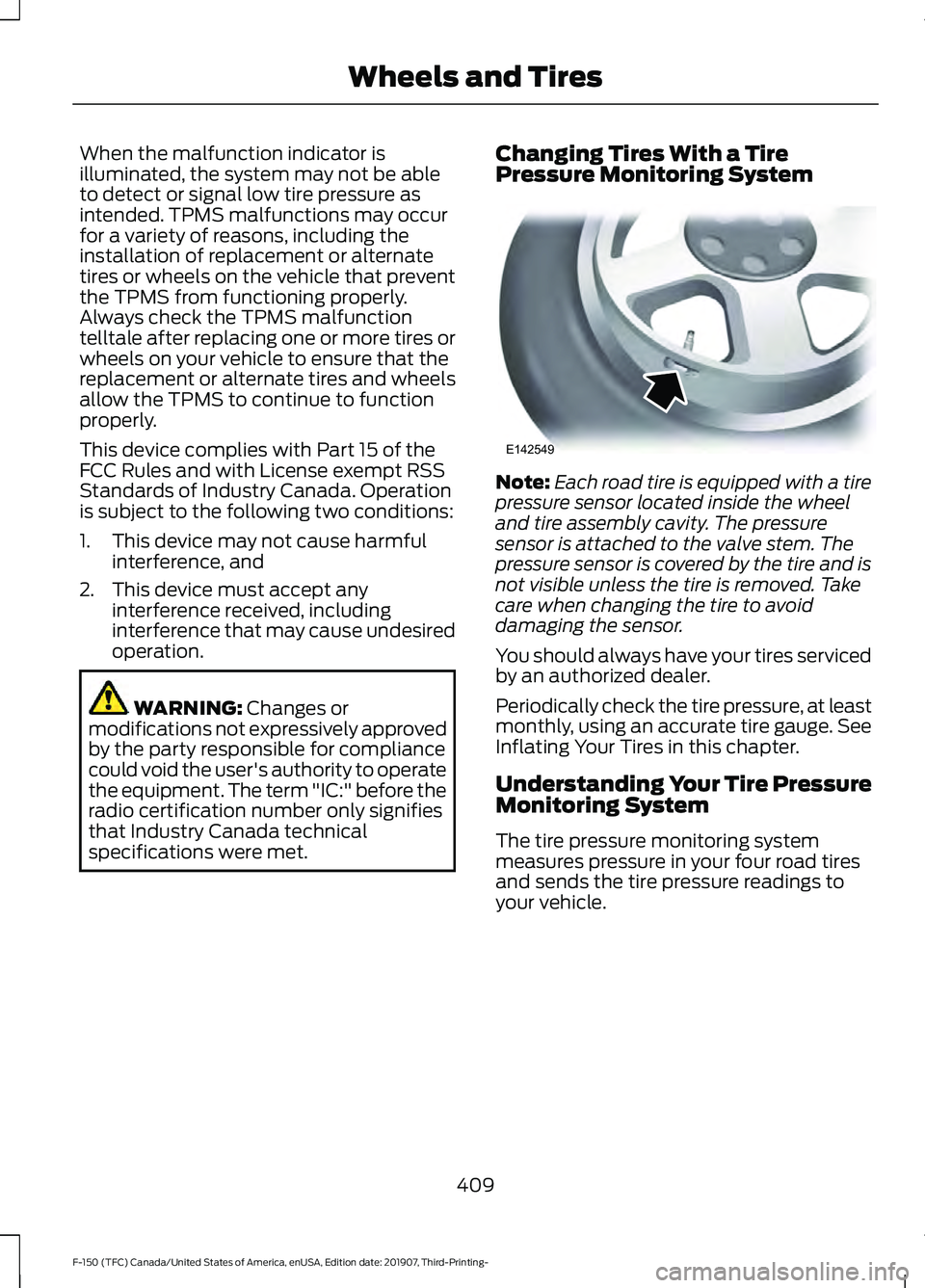
When the malfunction indicator is
illuminated, the system may not be able
to detect or signal low tire pressure as
intended. TPMS malfunctions may occur
for a variety of reasons, including the
installation of replacement or alternate
tires or wheels on the vehicle that prevent
the TPMS from functioning properly.
Always check the TPMS malfunction
telltale after replacing one or more tires or
wheels on your vehicle to ensure that the
replacement or alternate tires and wheels
allow the TPMS to continue to function
properly.
This device complies with Part 15 of the
FCC Rules and with License exempt RSS
Standards of Industry Canada. Operation
is subject to the following two conditions:
1. This device may not cause harmful
interference, and
2. This device must accept any interference received, including
interference that may cause undesired
operation. WARNING: Changes or
modifications not expressively approved
by the party responsible for compliance
could void the user's authority to operate
the equipment. The term "IC:" before the
radio certification number only signifies
that Industry Canada technical
specifications were met. Changing Tires With a Tire
Pressure Monitoring System Note:
Each road tire is equipped with a tire
pressure sensor located inside the wheel
and tire assembly cavity. The pressure
sensor is attached to the valve stem. The
pressure sensor is covered by the tire and is
not visible unless the tire is removed. Take
care when changing the tire to avoid
damaging the sensor.
You should always have your tires serviced
by an authorized dealer.
Periodically check the tire pressure, at least
monthly, using an accurate tire gauge. See
Inflating Your Tires in this chapter.
Understanding Your Tire Pressure
Monitoring System
The tire pressure monitoring system
measures pressure in your four road tires
and sends the tire pressure readings to
your vehicle.
409
F-150 (TFC) Canada/United States of America, enUSA, Edition date: 201907, Third-Printing- Wheels and TiresE142549
Page 423 of 625
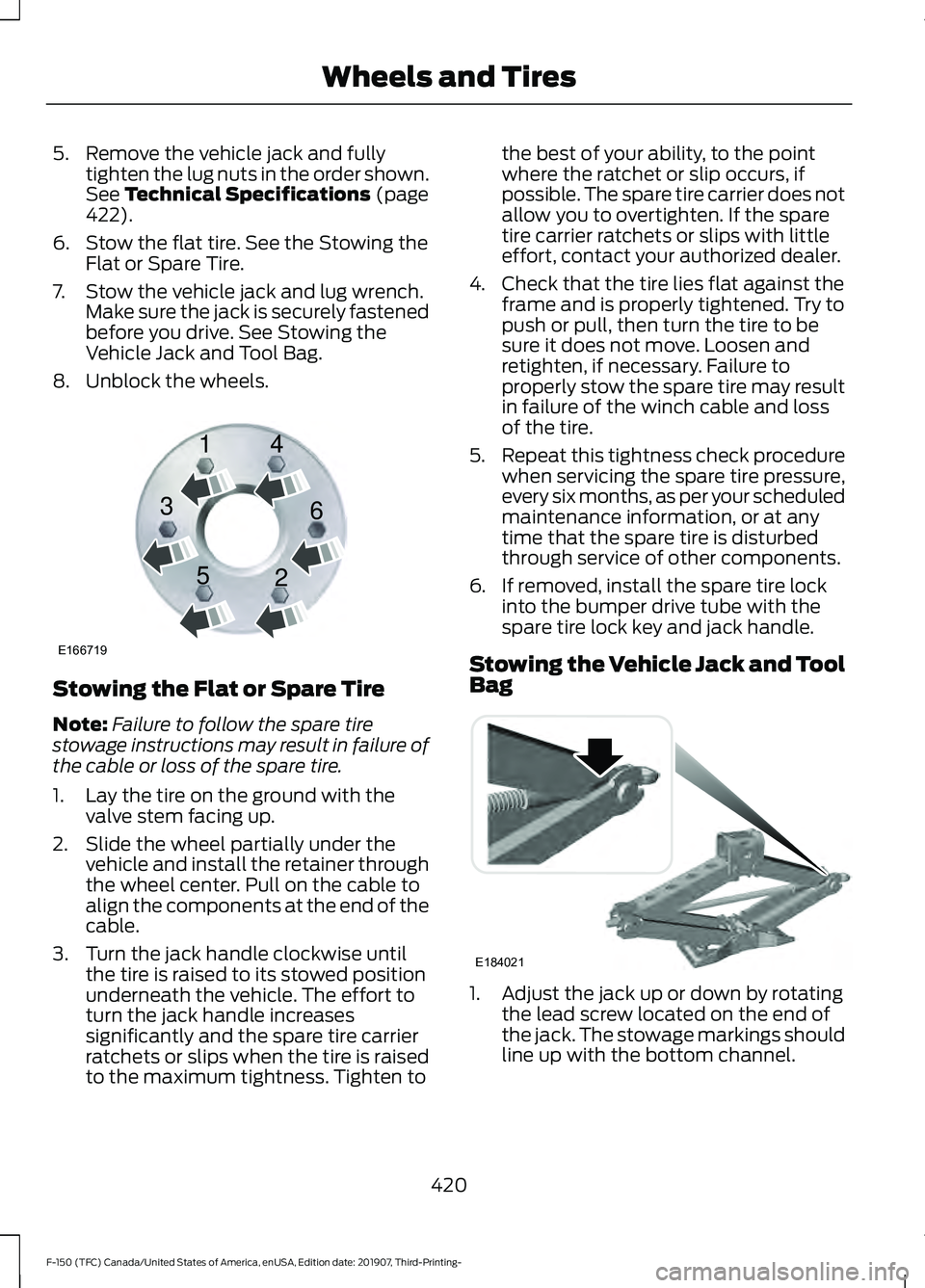
5. Remove the vehicle jack and fully
tighten the lug nuts in the order shown.
See Technical Specifications (page
422).
6. Stow the flat tire. See the Stowing the Flat or Spare Tire.
7. Stow the vehicle jack and lug wrench. Make sure the jack is securely fastened
before you drive. See Stowing the
Vehicle Jack and Tool Bag.
8. Unblock the wheels. Stowing the Flat or Spare Tire
Note:
Failure to follow the spare tire
stowage instructions may result in failure of
the cable or loss of the spare tire.
1. Lay the tire on the ground with the valve stem facing up.
2. Slide the wheel partially under the vehicle and install the retainer through
the wheel center. Pull on the cable to
align the components at the end of the
cable.
3. Turn the jack handle clockwise until the tire is raised to its stowed position
underneath the vehicle. The effort to
turn the jack handle increases
significantly and the spare tire carrier
ratchets or slips when the tire is raised
to the maximum tightness. Tighten to the best of your ability, to the point
where the ratchet or slip occurs, if
possible. The spare tire carrier does not
allow you to overtighten. If the spare
tire carrier ratchets or slips with little
effort, contact your authorized dealer.
4. Check that the tire lies flat against the frame and is properly tightened. Try to
push or pull, then turn the tire to be
sure it does not move. Loosen and
retighten, if necessary. Failure to
properly stow the spare tire may result
in failure of the winch cable and loss
of the tire.
5. Repeat this tightness check procedure
when servicing the spare tire pressure,
every six months, as per your scheduled
maintenance information, or at any
time that the spare tire is disturbed
through service of other components.
6. If removed, install the spare tire lock into the bumper drive tube with the
spare tire lock key and jack handle.
Stowing the Vehicle Jack and Tool
Bag 1. Adjust the jack up or down by rotating
the lead screw located on the end of
the jack. The stowage markings should
line up with the bottom channel.
420
F-150 (TFC) Canada/United States of America, enUSA, Edition date: 201907, Third-Printing- Wheels and TiresE166719
1
3
5 4
6
2 E184021
Page 425 of 625
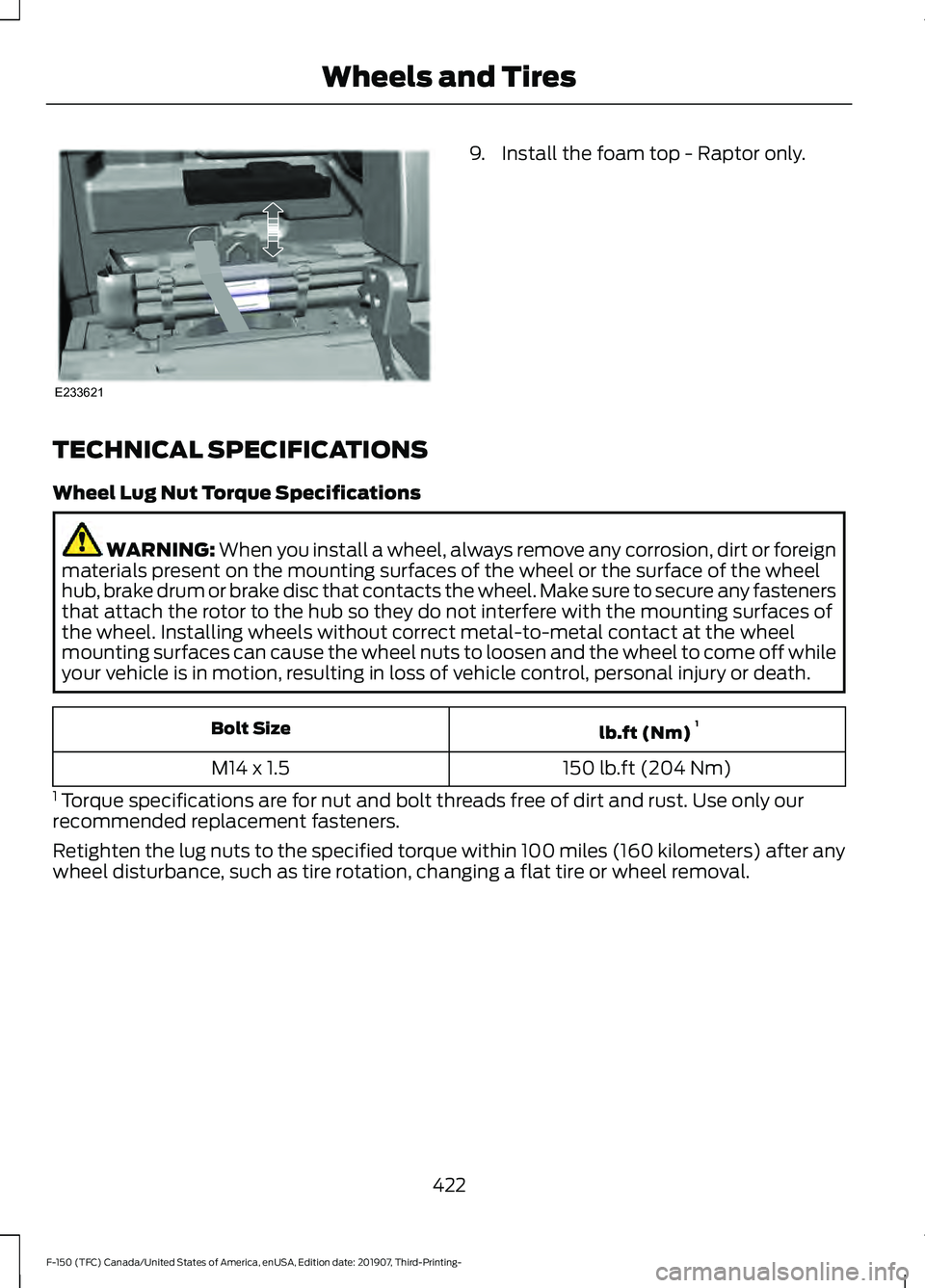
9. Install the foam top - Raptor only.
TECHNICAL SPECIFICATIONS
Wheel Lug Nut Torque Specifications WARNING: When you install a wheel, always remove any corrosion, dirt or foreign
materials present on the mounting surfaces of the wheel or the surface of the wheel
hub, brake drum or brake disc that contacts the wheel. Make sure to secure any fasteners
that attach the rotor to the hub so they do not interfere with the mounting surfaces of
the wheel. Installing wheels without correct metal-to-metal contact at the wheel
mounting surfaces can cause the wheel nuts to loosen and the wheel to come off while
your vehicle is in motion, resulting in loss of vehicle control, personal injury or death. lb.ft (Nm)
1
Bolt Size
150 lb.ft (204 Nm)
M14 x 1.5
1 Torque specifications are for nut and bolt threads free of dirt and rust. Use only our
recommended replacement fasteners.
Retighten the lug nuts to the specified torque within 100 miles (160 kilometers) after any
wheel disturbance, such as tire rotation, changing a flat tire or wheel removal.
422
F-150 (TFC) Canada/United States of America, enUSA, Edition date: 201907, Third-Printing- Wheels and TiresE233621
Page 606 of 625
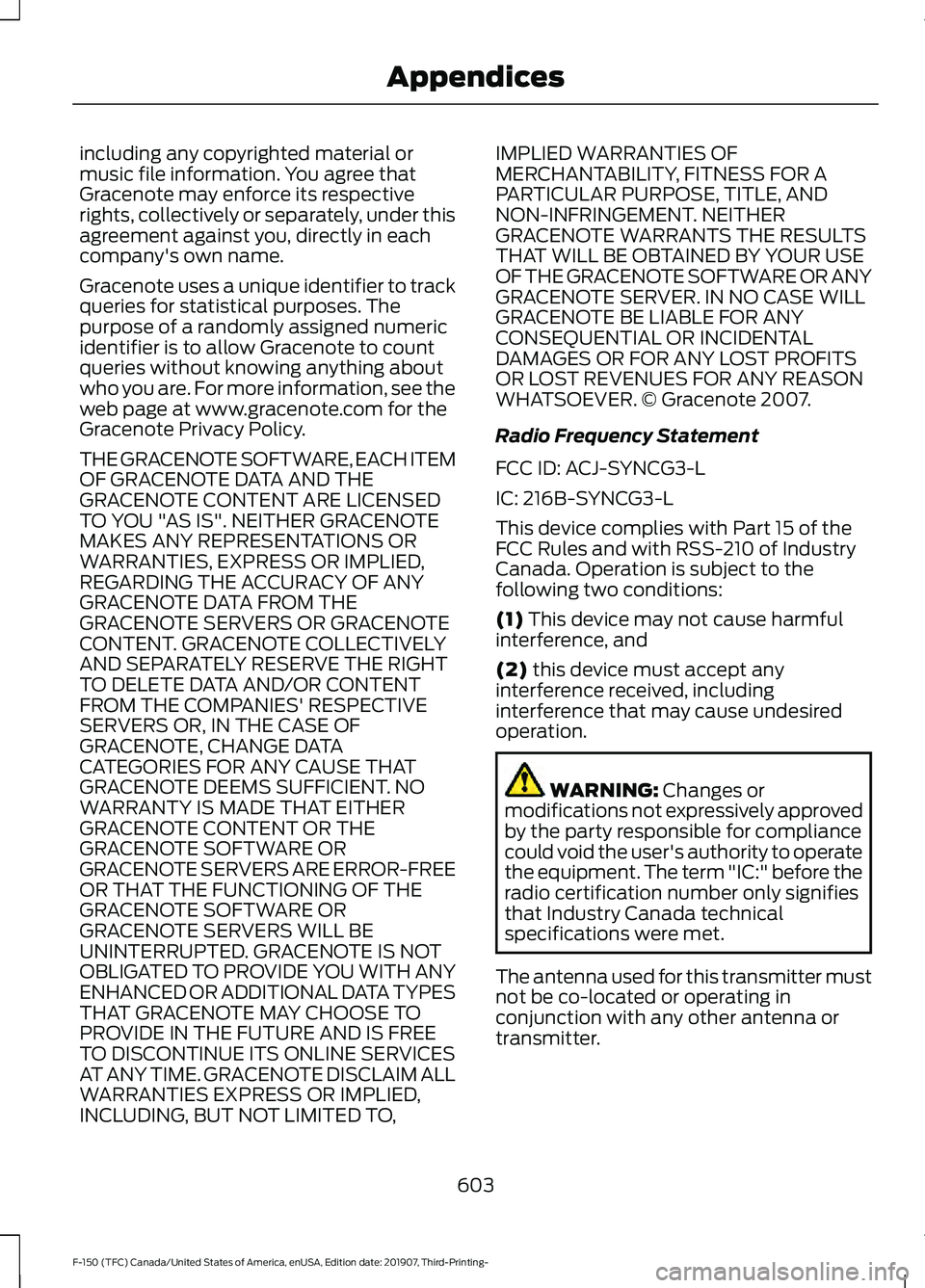
including any copyrighted material or
music file information. You agree that
Gracenote may enforce its respective
rights, collectively or separately, under this
agreement against you, directly in each
company's own name.
Gracenote uses a unique identifier to track
queries for statistical purposes. The
purpose of a randomly assigned numeric
identifier is to allow Gracenote to count
queries without knowing anything about
who you are. For more information, see the
web page at www.gracenote.com for the
Gracenote Privacy Policy.
THE GRACENOTE SOFTWARE, EACH ITEM
OF GRACENOTE DATA AND THE
GRACENOTE CONTENT ARE LICENSED
TO YOU "AS IS". NEITHER GRACENOTE
MAKES ANY REPRESENTATIONS OR
WARRANTIES, EXPRESS OR IMPLIED,
REGARDING THE ACCURACY OF ANY
GRACENOTE DATA FROM THE
GRACENOTE SERVERS OR GRACENOTE
CONTENT. GRACENOTE COLLECTIVELY
AND SEPARATELY RESERVE THE RIGHT
TO DELETE DATA AND/OR CONTENT
FROM THE COMPANIES' RESPECTIVE
SERVERS OR, IN THE CASE OF
GRACENOTE, CHANGE DATA
CATEGORIES FOR ANY CAUSE THAT
GRACENOTE DEEMS SUFFICIENT. NO
WARRANTY IS MADE THAT EITHER
GRACENOTE CONTENT OR THE
GRACENOTE SOFTWARE OR
GRACENOTE SERVERS ARE ERROR-FREE
OR THAT THE FUNCTIONING OF THE
GRACENOTE SOFTWARE OR
GRACENOTE SERVERS WILL BE
UNINTERRUPTED. GRACENOTE IS NOT
OBLIGATED TO PROVIDE YOU WITH ANY
ENHANCED OR ADDITIONAL DATA TYPES
THAT GRACENOTE MAY CHOOSE TO
PROVIDE IN THE FUTURE AND IS FREE
TO DISCONTINUE ITS ONLINE SERVICES
AT ANY TIME. GRACENOTE DISCLAIM ALL
WARRANTIES EXPRESS OR IMPLIED,
INCLUDING, BUT NOT LIMITED TO,
IMPLIED WARRANTIES OF
MERCHANTABILITY, FITNESS FOR A
PARTICULAR PURPOSE, TITLE, AND
NON-INFRINGEMENT. NEITHER
GRACENOTE WARRANTS THE RESULTS
THAT WILL BE OBTAINED BY YOUR USE
OF THE GRACENOTE SOFTWARE OR ANY
GRACENOTE SERVER. IN NO CASE WILL
GRACENOTE BE LIABLE FOR ANY
CONSEQUENTIAL OR INCIDENTAL
DAMAGES OR FOR ANY LOST PROFITS
OR LOST REVENUES FOR ANY REASON
WHATSOEVER. © Gracenote 2007.
Radio Frequency Statement
FCC ID: ACJ-SYNCG3-L
IC: 216B-SYNCG3-L
This device complies with Part 15 of the
FCC Rules and with RSS-210 of Industry
Canada. Operation is subject to the
following two conditions:
(1) This device may not cause harmful
interference, and
(2)
this device must accept any
interference received, including
interference that may cause undesired
operation. WARNING:
Changes or
modifications not expressively approved
by the party responsible for compliance
could void the user's authority to operate
the equipment. The term "IC:" before the
radio certification number only signifies
that Industry Canada technical
specifications were met.
The antenna used for this transmitter must
not be co-located or operating in
conjunction with any other antenna or
transmitter.
603
F-150 (TFC) Canada/United States of America, enUSA, Edition date: 201907, Third-Printing- Appendices
Page 609 of 625
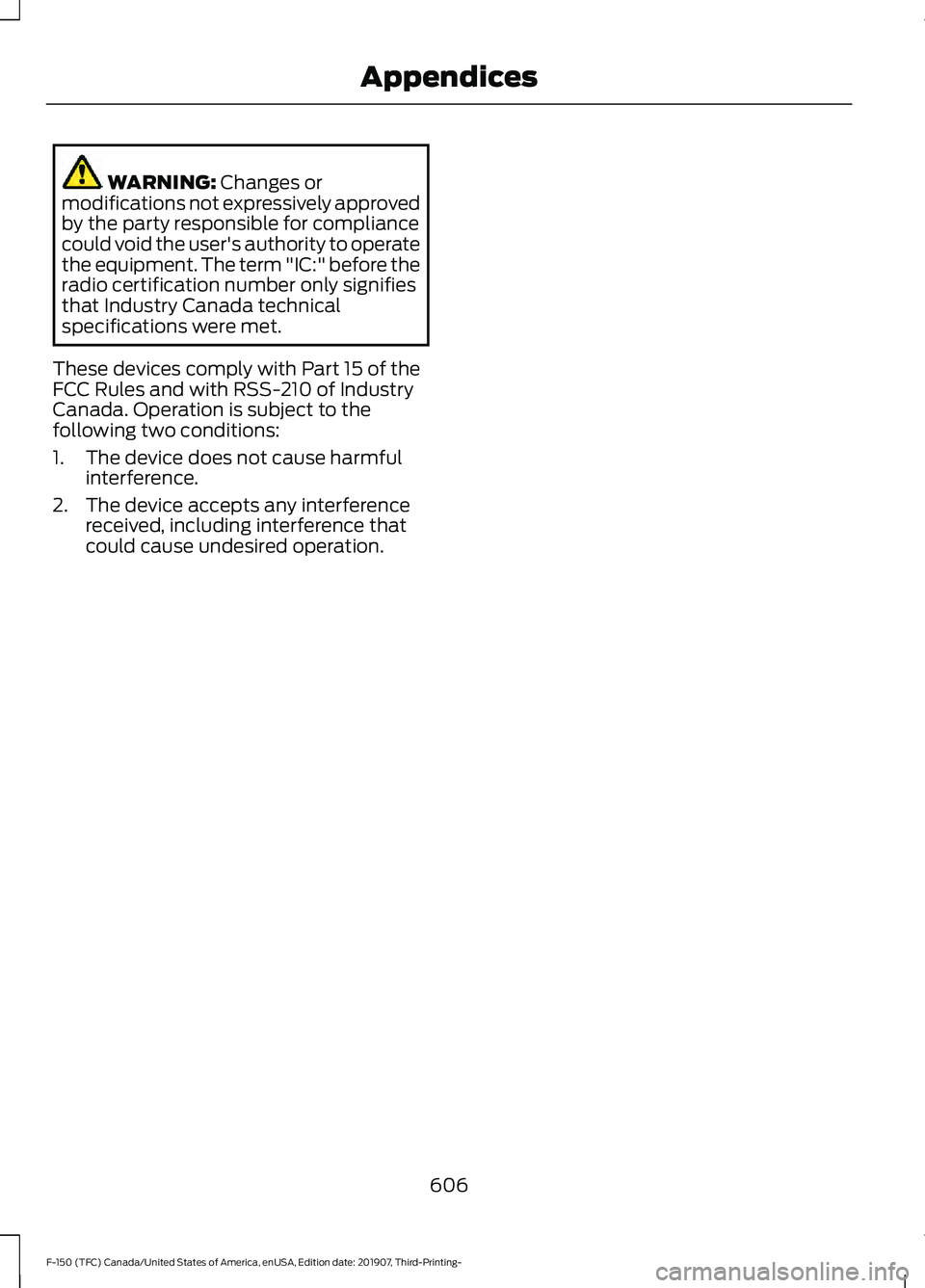
WARNING: Changes or
modifications not expressively approved
by the party responsible for compliance
could void the user's authority to operate
the equipment. The term "IC:" before the
radio certification number only signifies
that Industry Canada technical
specifications were met.
These devices comply with Part 15 of the
FCC Rules and with RSS-210 of Industry
Canada. Operation is subject to the
following two conditions:
1. The device does not cause harmful interference.
2. The device accepts any interference received, including interference that
could cause undesired operation.
606
F-150 (TFC) Canada/United States of America, enUSA, Edition date: 201907, Third-Printing- Appendices
Page 623 of 625

Starting and Stopping the Engine..........179
General Information........................................... 179
Steering............................................................273 Adaptive Learning.............................................. 274
Electric Power Steering.................................... 273
Steering Wheel Lock - Vehicles With: Push Button Start.....................................180
Unlocking the Steering Wheel...................... 180
Steering Wheel Lock - Vehicles Without: Push Button Start.....................................180
Steering Wheel...............................................88
Storage Compartments..............................177
Sunroof See: Moonroof..................................................... 109
Sun Visors
.......................................................108
Illuminated Vanity Mirror................................. 108
Supplementary Restraints System
..........51
Principle of Operation.......................................... 51
Switching Automatic High Beam Control On and Off....................................................101
Activating the Automatic High Beam Control................................................................ 101
Switching Cruise Control On and Off...................................................................253
Switching Cruise Control Off......................... 253
Switching Cruise Control On......................... 253
Switching Off the Engine..........................188
Switching Rear Occupant Alert System On and Off...................................................169
Symbols Glossary
.............................................9
SYNC™ 3........................................................505
General Information......................................... 505
SYNC™ 3 Troubleshooting......................537 Additional Information and
Assistance....................................................... 549
Apps....................................................................... 544
Navigation............................................................ 543
Personal Profiles................................................ 547
Phone...................................................................... 541
Resetting the System...................................... 549
USB and Bluetooth Audio.............................. 538
Voice Recognition.............................................. 537
Wi-Fi Connectivity............................................. 546
SYNC™ Applications and Services........................................................492
911 Assist............................................................... 492
SYNC Mobile Apps........................................... 494SYNC™...........................................................488
General Information......................................... 488
SYNC™ Troubleshooting.........................496
T
Tailgate Lock
.....................................................77
Tailgate Step....................................................79
Closing the Step................................................... 80
Opening the Step................................................. 79
Tailgate...............................................................77
Technical Specifications See: Capacities and Specifications............424
The Better Business Bureau (BBB) Auto Line Program (U.S. Only).......................339
Tire Care
..........................................................392
Glossary of Tire Terminology........................ 393
Information About Uniform Tire Quality Grading............................................................. 392
Information Contained on the Tire Sidewall........................................................... 394
Temperature A B C............................................ 393
Traction AA A B C.............................................. 393
Treadwear............................................................. 392
Tire Pressure Monitoring System..........408 Changing Tires With a Tire Pressure
Monitoring System...................................... 409
Understanding Your Tire Pressure Monitoring System ..................................... 409
Tires See: Wheels and Tires...................................... 391
Towing a Trailer
............................................290
Load Placement.................................................. 291
Towing Points
...............................................336
Towing the Vehicle on Four Wheels...........................................................321
Emergency Towing............................................. 321
Recreational Towing.......................................... 321
Towing.............................................................290
Traction Control
............................................237
Principle of Operation....................................... 237
Trailer Reversing Aids.................................292 Principle of Operation...................................... 292
Pro Trailer Backup Assist™............................ 292
Setting Up Pro Trailer Backup Assist..........292
Troubleshooting................................................. 297
Using Pro Trailer Backup Assist................... 296
Trailer Sway Control...................................302
620
F-150 (TFC) Canada/United States of America, enUSA, Edition date: 201907, Third-Printing- Index
Page 625 of 625
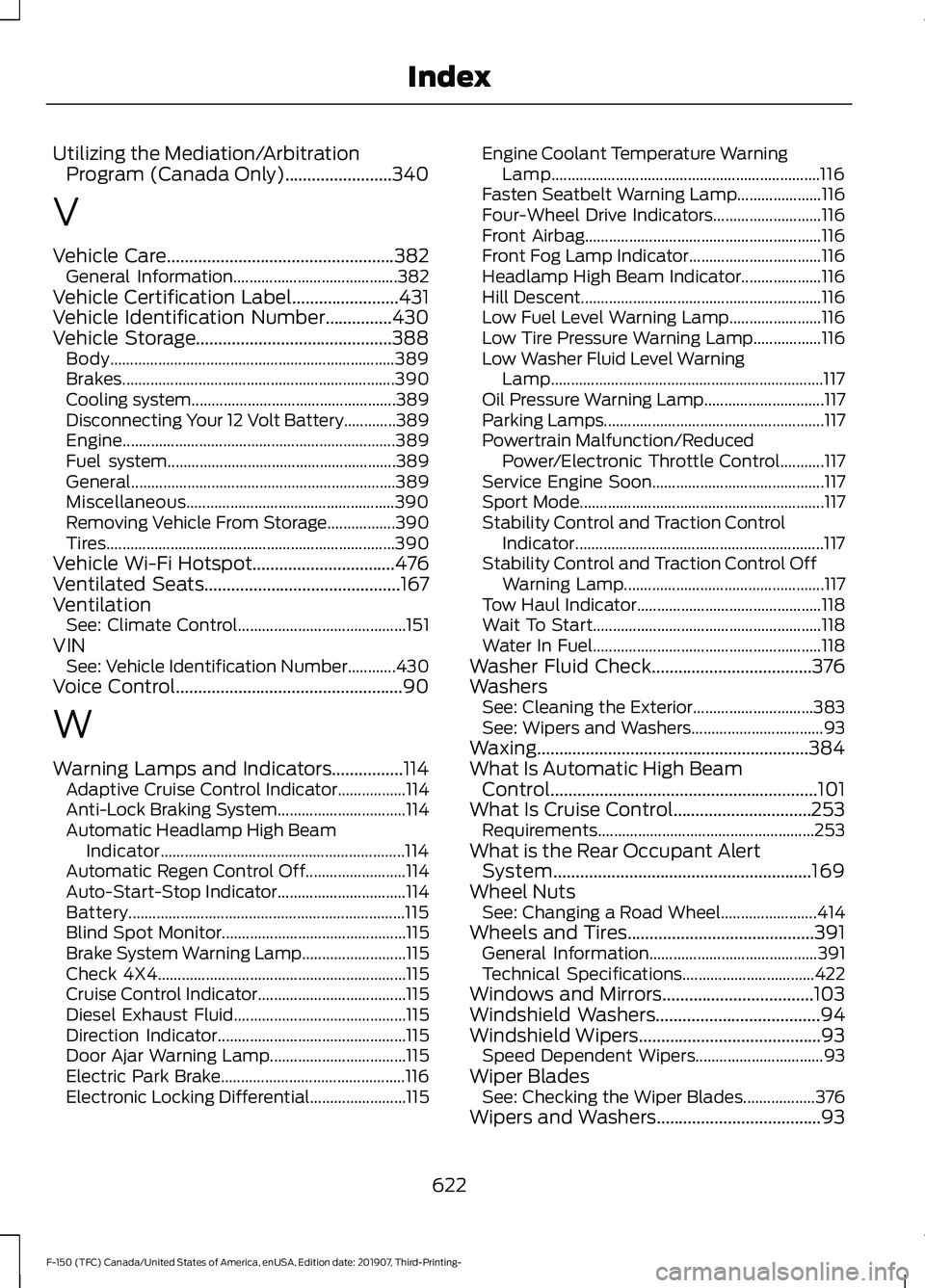
Utilizing the Mediation/Arbitration
Program (Canada Only)........................340
V
Vehicle Care...................................................382
General Information......................................... 382
Vehicle Certification Label
........................431
Vehicle Identification Number...............430
Vehicle Storage............................................388 Body....................................................................... 389
Brakes.................................................................... 390
Cooling system................................................... 389
Disconnecting Your 12 Volt Battery.............389
Engine.................................................................... 389
Fuel system......................................................... 389
General.................................................................. 389
Miscellaneous.................................................... 390
Removing Vehicle From Storage.................390
Tires........................................................................\
390
Vehicle Wi-Fi Hotspot
................................476
Ventilated Seats............................................167
Ventilation See: Climate Control.......................................... 151
VIN See: Vehicle Identification Number............430
Voice Control
...................................................90
W
Warning Lamps and Indicators................114 Adaptive Cruise Control Indicator.................114
Anti-Lock Braking System................................ 114
Automatic Headlamp High Beam Indicator............................................................. 114
Automatic Regen Control Off......................... 114
Auto-Start-Stop Indicator................................ 114
Battery..................................................................... 115
Blind Spot Monitor.............................................. 115
Brake System Warning Lamp.......................... 115
Check 4X4.............................................................. 115
Cruise Control Indicator..................................... 115
Diesel Exhaust Fluid........................................... 115
Direction Indicator............................................... 115
Door Ajar Warning Lamp.................................. 115
Electric Park Brake.............................................. 116
Electronic Locking Differential........................ 115Engine Coolant Temperature Warning
Lamp................................................................... 116
Fasten Seatbelt Warning Lamp..................... 116
Four-Wheel Drive Indicators........................... 116
Front Airbag........................................................... 116
Front Fog Lamp Indicator................................. 116
Headlamp High Beam Indicator.................... 116
Hill Descent............................................................ 116
Low Fuel Level Warning Lamp....................... 116
Low Tire Pressure Warning Lamp.................116
Low Washer Fluid Level Warning Lamp
.................................................................... 117
Oil Pressure Warning Lamp.............................. 117
Parking Lamps....................................................... 117
Powertrain Malfunction/Reduced Power/Electronic Throttle Control...........117
Service Engine Soon........................................... 117
Sport Mode............................................................. 117
Stability Control and Traction Control Indicator.............................................................. 117
Stability Control and Traction Control Off Warning Lamp.................................................. 117
Tow Haul Indicator.............................................. 118
Wait To Start......................................................... 118
Water In Fuel......................................................... 118
Washer Fluid Check
....................................376
Washers See: Cleaning the Exterior.............................. 383
See: Wipers and Washers................................. 93
Waxing.............................................................384
What Is Automatic High Beam Control............................................................101
What Is Cruise Control...............................253 Requirements...................................................... 253
What is the Rear Occupant Alert System
..........................................................169
Wheel Nuts See: Changing a Road Wheel........................ 414
Wheels and Tires
..........................................391
General Information.......................................... 391
Technical Specifications................................. 422
Windows and Mirrors
..................................103
Windshield Washers.....................................94
Windshield Wipers.........................................93 Speed Dependent Wipers................................ 93
Wiper Blades See: Checking the Wiper Blades.................. 376
Wipers and Washers.....................................93
622
F-150 (TFC) Canada/United States of America, enUSA, Edition date: 201907, Third-Printing- Index